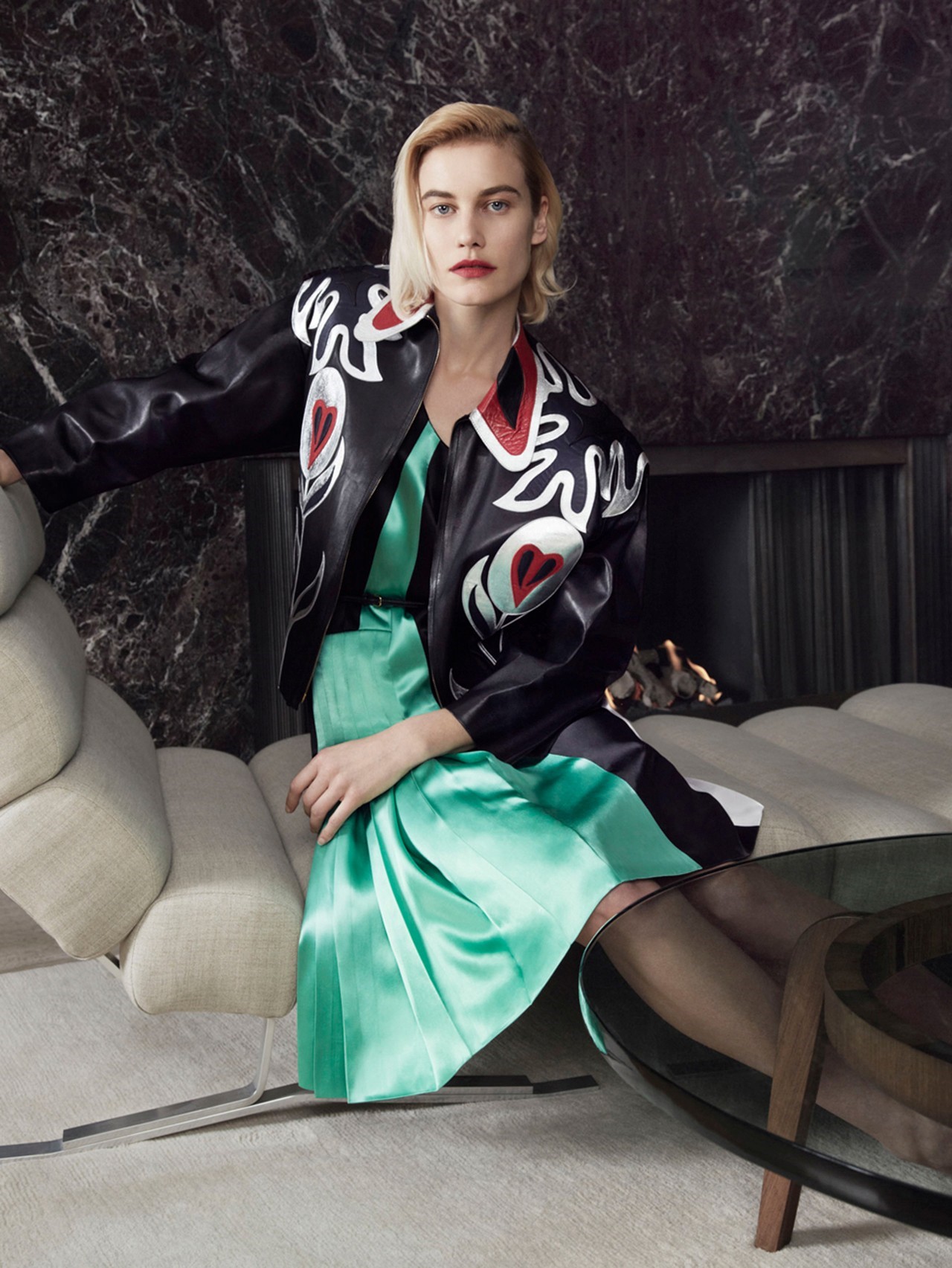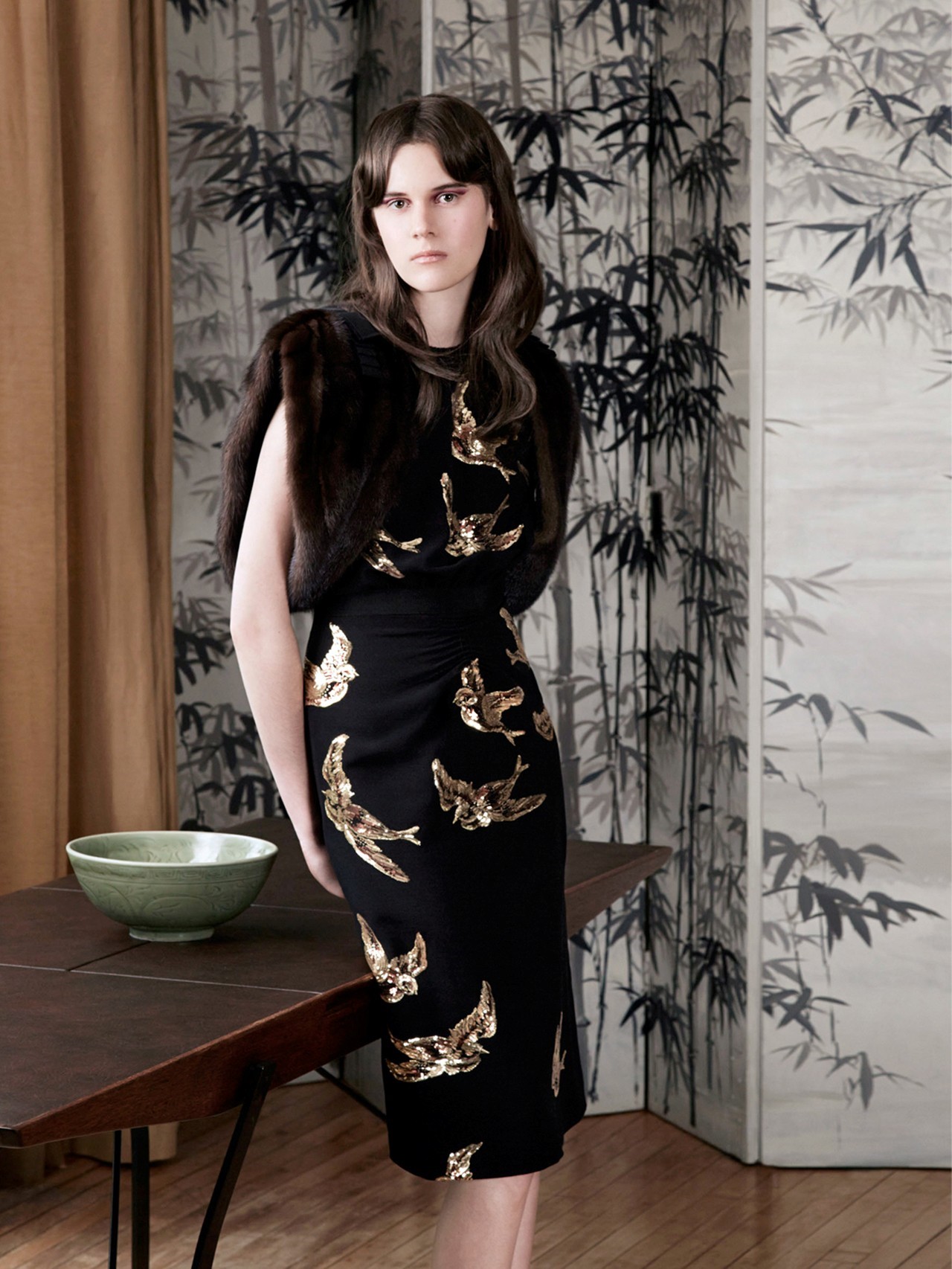Miu Miu was 1993’s greatest gift to fashion. Here, Dean Mayo Davies looks back at the label that dressed a generation
Context is everything. Although Prada was founded in 1913 by Miuccia Prada’s grandfather Mario as a luxury leather-goods business, it only became a fashion force to be reckoned with after his descendent inherited the company in 1978. She quickly shook things up, creating the first line of her black military-grade nylon backpacks in 1979. While the humble techno luggage, a volte-face from what a luxury bag was supposed to look like, was a tough sell in the 80s – the age of logomania, after all – it would become the schlepper synonymous with the 90s.
It also provided the foundation for the label’s move into ready-to-wear in the late 80s (women) and mid-90s (men). The reason you’ve heard of Prada now – and you have, you’ll recognise the clothes even if you avoid style blogs like the plague – is Miuccia’s doing.
Hers is an ongoing legacy, not that she would have known what her innovations would accomplish at the time. Her clothes, a mix of fabulous and dowdy, became a sort of ready-to-wear crack pipe for stylists and famous fans like Raf Simons and Marc Jacobs. The world’s most regarded editors race to her Montenapoleone store during Milan fashion week to claim the new looks first. Rifts have begun over knitwear on that smart chequerboard floor. No exaggeration.
Alongside the tangible ascension of her grandad’s luggage brand in the world of hardcore fashion, Miuccia wanted a more personal counterpart. Thus along came Miu Miu in 1993, titled after her nickname. It carries her spirit: intuitive, playful, clever and contrary, a subversive take on the elder label’s hammering of the bourgeois code. The story goes that as a youngster, Miuccia Prada would be dressed in Yves Saint Laurent handing out Communist Party flyers. That’s an enduring metaphor.
Miu Miu doesn’t apologise or justify itself, because humans are complex and expression can be complex too – as perversely as it can be antagonisingly simple. Carrying a bubblegum pink bag doesn’t by default make you an airhead, just as wearing a blouse buttoned up to the top doesn’t mean you’re a prim intellectual. Understanding that goes some way to understanding just why Miu Miu speaks so eloquently to women; it’s intellectual as well as emotional. Forgive the next sweeping statement, even if it is a total compliment, but there are few girls who don’t like this brand. Go on, ask around.
“Miu Miu is the younger sister of Prada and that’s exactly how I feel,” says veteran Belgian model Hannelore Knuts, who has walked for Miu Miu throughout her career. “Young and fresh and smart. My first show was kind of funny because I was the schoolbook example of ‘the beginner’ – it was my first season ever as a model! I didn’t understand my call sheet and didn’t realise they do two shows right after each other. So there I am saying goodbye to everybody, walking out after the first. Thank God somebody said something to me! If I didn’t know much at the time I knew Miu Miu made you feel good. I think any healthy woman happy with herself will always cherish the little girl she was. Miu Miu makes you feel young in a good way. And has a beautiful sense of humour too, which I say with respect.”
Sweden’s Sara Blomqvist, a catwalk staple since 2007, concurs. “(Walking for Miu Miu) is a very special feeling as it is the last show of the season for the hair, make-up teams and most of the girls – and that gives everyone a second wind and a certain energy. The strongest memory I have is from when I closed the show back in AW09. The runway went through three rooms, so when we did the finale everyone in the first room had stood up and were ready to leave as we were coming round. I remember not knowing what to do and having to fight my way backstage. In the chaos I nearly knocked over Eva Mendes.”
Models and film stars do cross paths with this brand, though thankfully not usually as literally as in Blomqvist’s experience. Following Miu Miu’s inaugural campaigns – the very first featured Rosemary Ferguson neo-realistically shot by Corinne Day – the notion of the layered, multifaceted personality was introduced with the casting of Drew Barrymore in 1995. Putting clothes on an actress is a great signifier of that.
Since then, we’ve seen the likes of – deep breath – Maggie Gyllenhaal, Laetitia Casta, Selma Blair, Kirsten Dunst, Evan Rachel Wood, Ludivine Sagnier, Katie Holmes, Vanessa Paradis, Mia Wasikowska, Kim Basinger, Lindsay Lohan and Lou Doillon all front the brand. Chloë Sevigny is the only actress to have been the face of Miu Miu twice, for SS96 shot by Juergen Teller, and AW12 by Mert and Marcus. (Compare the two series to chart her subtle evolution.) Meanwhile, the then 14-year-old actress Hailee Steinfeld was shot by Bruce Weber for AW11.
“It was a huge honour for me,” Steinfeld tells Dazed. “I didn’t realise the magnitude at the time, but to shoot with Bruce Weber and meet Mrs Prada and her entire working family was a sincere once-in-a-lifetime pleasure. Being a part of their world has been incredibly special to me.” Her breakout movie, the Coens’ True Grit, was released at the time of the campaign. “My fondest memory is when I wore the swan-motif dress from spring 2011 to the opening (of True Grit) at the Berlin Film Festival,” she remembers. “I will never forget the excitement of standing in a sea of photographers on that red carpet, and how much I adored that look for its whimsy and its beauty.”
The campaign attracted controversy due to the fact that Steinfield was literally playing on railway tracks in it. The Daily Mail – obviously – and online messageboards had a field day. God help us if they ever understand the power of visual metaphor.
One common misconception about Miu Miu was that it was linked to grunge. (That story belongs to Marc Jacobs’ shortlived reign at Perry Ellis.) There was a chasmic difference between the neorealism which established this label and the threadbare glamour of Seattle, where music was all-important. What underscored both was a cultural hunger for personality and stripping away of hyperbole. Following the 80s, a decade where Mugler and Montana were kings, style reacted by losing the make-up and chucking the shoulder pads in the bin.
The Miu Miu lexicon, full of surprising short-circuits between masculine/feminine, prints, couture, sport and, yes, the bourgeoisie was given extra definition when Miuccia began showing the label in Paris in 2006, while Prada remained in Milan. Delfine Bafort, who debuted for Miu Miu in the 90s and stars in the shoot on these pages, identifies with the label’s carefree side. “I don’t like the feeling of fashion where there’s too much thinking,” she ponders. It’s just a beautiful, sophisticated brand without trying too much. It’s so authentic and special.”
For AW13, Miuccia morphed MA-1s into dresses and clad Mary-Janes with tyre tread, adding polka-dot neckerchiefs. Seasons before, we’ve seen crumpled film-noir, 70s dandy, 40s glamour and, er, The X Factor. The latter appeared in the brilliantly unhinged SS11 collection, which saw Mrs Prada address the zeitgeist more explicitly than ever, with Dancing on Ice-friendly star motifs, neon details, Simon-pick-me spirit and even a Cheryl Cole commentary ripped from TV on the soundtrack. Spinning a desperate, suffocating culture into an empowering, ironic, sexy fuck-you is quite a feat.
What’s exciting about this label is that the girls it emerged with became women, and it has grown with them. The brand was a mirror that gave a generation the tools of expression. The same women can, and do, wear Miu Miu today. The trinkets might change season-by-season, but the same spirit remains, beyond the whims of colour palette or heel height.
Leave it to Steinfeld, then, to sum up just why Miu Miu has made an indelible mark over the last two decades. “It’s Mrs Prada.” We couldn’t have put it better ourselves.
MIU MIU ARCHIVE: THE MIU AGE
TEXT DEAN MAYO DAVIES
PHOTOGRAPHY BEN TOMS
FASHION ROBBIE SPENCER
DAZED & CONFUSED, AUGUST 2013















